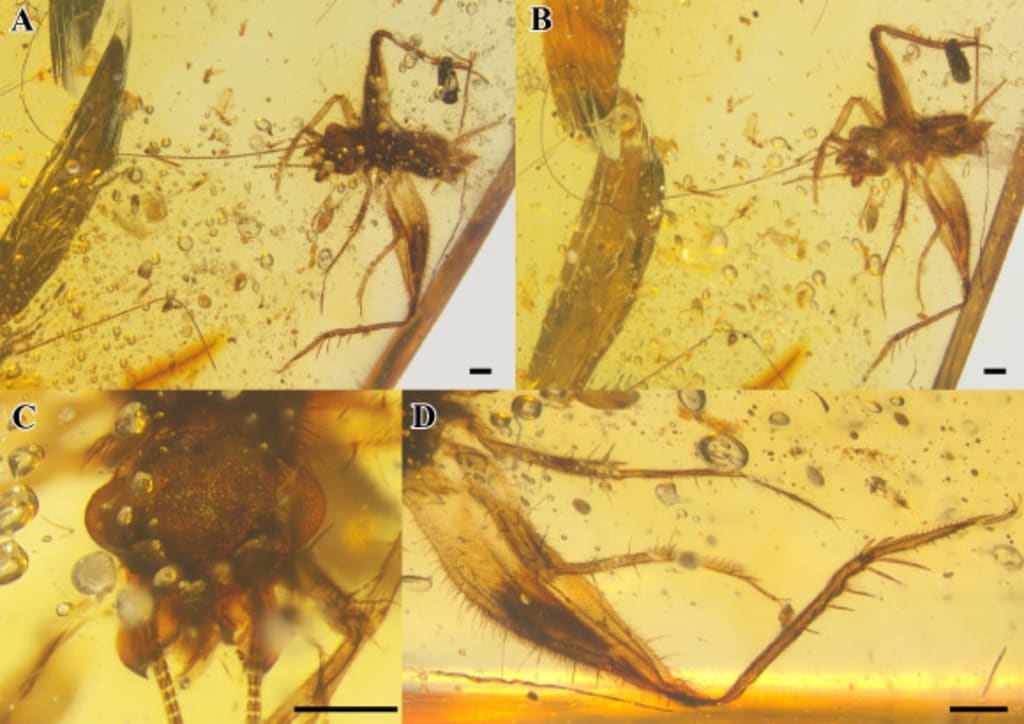Content warning
This story may contain sensitive material or discuss topics that some readers may find distressing. Reader discretion is advised. The views and opinions expressed in this story are those of the author and do not necessarily reflect the official policy or position of Vocal.
Time Capsule Discovery: New Cricket Species Emerges from 99-Million-Year-Old Amber
The Earth's history is a treasure trove of secrets, often concealed in the depths of time. In a stunning revelation, a recently discovered cricket species has emerged from the golden embrace of 99-million-year-old amber, offering a glimpse into a world long past and a testament to the wonders of preservation in amber

The past of our planet is a veritable treasury full with mysteries, many of which have been carefully guarded all these eons. A freshly discovered species of cricket has been found emerging from the golden embrace of amber that is 99 million years old. This astounding discovery provides a glimpse into a world that has long since passed and is a tribute to the marvels of preservation in amber.
The natural time capsule that is amber
Amber, which is tree resin that has been petrified, has the remarkable capacity to preserve moments from a very long time ago. When little creatures become encased in this sticky substance, they have an incredible chance of being preserved for millions of years in an almost perfect state. Because of this natural process, we are able to recover extinct species and historic ecosystems that would have otherwise been lost to history.
The Mystery That Is 99 Million Years Old
The species of cricket that was only recently discovered preserved in amber dates back to the middle of the Cretaceous period, which was roughly 99 million years ago. This places it at a time when dinosaurs still roamed the Earth and flowering plants were only starting to develop into their many different forms. The discovery of a specimen from this time period that has been preserved for all these years is a momentous occasion for paleontologists and entomologists alike.
A New Species of the Cricket
The fact that the cricket that was found in the amber looks to be a member of a species that has never been described before makes this discovery all the more astounding. Researchers are now gaining vital insights on the diversity of insect life in the ancient world because to this creature's one-of-a-kind characteristics and attributes.
The Significance of Amber's Prehistoric Remains
Amber fossils are extremely precious pieces of historical evidence. Amber preserves specimens in three-dimensional detail, providing a level of clarity and completeness that is unmatched by other types of fossils. Traditional fossils, on the other hand, can get flattened or broken with time. This presents researchers with an opportunity to learn about long-extinct creatures in a manner that cannot be matched by traditional fossils.
Beyond Scientific Understandings and Insights
The discovery of a new species of cricket preserved in amber has a number of repercussions, both in the scientific world and beyond:
1. Insights into Evolution: The study of ancient insects such as this cricket helps scientists track the evolutionary history of distinct species. This sheds light on how different species adapted to the surroundings in which they lived and diversified over time.
2. The Evolution of Biodiversity This discovery contributes to our overall comprehension of the diversity of life that was present during the Cretaceous epoch. It illustrates that even organisms as seemingly little and delicate as crickets played a part in the ecosystems that existed millions of years ago.
3. Preserved in Amber The extraordinary preservation of this cricket in amber demonstrates the one-of-a-kind properties of amber as a time capsule for ancient life. It highlights the significance of preserving amber deposits all over the world to preserve the survival of priceless fossils, as this is essential for scientific research.
4. Involvement of the Public: Discoveries such as this one captivate the interest of people from all walks of life. They reawaken in us an ever-present sense of wonder and curiosity about the history of our planet and the creatures that have inhabited it in the past.
Proceeding onward in Our Search for Knowledge
As we gape in awe at the discovery of this cricket that is estimated to be 99 million years old, we are reminded that the planet we live in is a treasure trove of mysteries just waiting to be solved. The field of paleontology and the study of fossils preserved in amber bring us one step closer to comprehending the complex web of life that exists on our planet with each new discovery.
This cricket, which used to live in a distant setting, now serves as a metaphor for resiliency, persistence, and the enduring beauty of nature's creation. Knowing that each discovery takes us closer to deciphering the enigmas of the past inspires us to carry on with our pursuit of information and to take care of the irreplaceable artifacts that are all that are left of the rich history of our planet.
About the Creator
Stephen Keith B. Labto
Keith's transition from computer engineer to passionate writer was unique. Keith's curiosity and imagination pushed him to try something new. He invites readers to explore knowledge's various and beautiful landscapes one word at a time.
Enjoyed the story? Support the Creator.
Subscribe for free to receive all their stories in your feed. You could also pledge your support or give them a one-off tip, letting them know you appreciate their work.






Comments
There are no comments for this story
Be the first to respond and start the conversation.